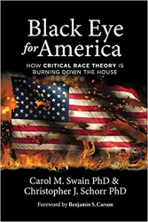Black Eye for America
How Critical Race Theory is Burning Down the House
by Carol M. Swain, Ph.D. and Christopher J. Schorr, Ph.D., Be the People Books, 2021
Much has been written in recent years about the scourge of Critical Race Theory (CRT), which currently has a stranglehold on our culture in general and our education system in particular. The corruption of CRT took hold years ago at the university level and has trickled down to our youngest students, today impacting even first graders. But while there are many good sources of information about this racist and divisive topic, the new book by author, public speaker, and retired university professor, Dr. Carol Swain, and researcher and American Government scholar, Dr. Christopher Schorr, should rank at or near the top of the list. All who have been touched by CRT in any way, or who know of its threat to drag our country backward, should avail themselves of this excellent resource.
 Black Eye for America offers a comprehensive explanation of CRT, its origins, its familial relationship with Marxism, and its pernicious influences. But perhaps more important than their thorough discussion of the issue itself, the authors offer a road map of strategies and tactics for fighting back.
Black Eye for America offers a comprehensive explanation of CRT, its origins, its familial relationship with Marxism, and its pernicious influences. But perhaps more important than their thorough discussion of the issue itself, the authors offer a road map of strategies and tactics for fighting back.
From the opening pages of the book, the authors acknowledge "the nation's tragic racial past and the strides that have been made to create a more just society." They profess their Christian belief that "God created one human race," and that "racism and prejudice are always wrong and should always be condemned regardless of the race or ethnicity of the perpetrator." They approach CRT with staunch opposition "to political activism and indoctrination disguised as education and to so-called 'antiracism' programs and training that, in reality, use racism as an attempted remedy for racial and ethnic disparities."
In defining CRT, Swain and Schorr demonstrate how for white people there is no way out of the charge of racism. If they believe in the color-blind society envisioned by Dr. Martin Luther King Jr., for example, they are told that "ignoring skin color is racist." If they are descendants of abolitionists or come from families whose philanthropy includes financial support for black colleges and other ethnic organizations, they are nonetheless guilty of "harboring hidden racial biases." White people, the authors note, "are 'oppressors' by definition. Christianity, and Western civilization more broadly, also falls into the oppressor category."
On the other hand, they observe, "racial and ethnic minorities, especially black people, are described as helpless victims in need of liberation from pervasive and persistent racism. This patronizing account strips minorities of ownership and control over their own lives while attributing to whites seemingly godlike powers to create every sort of malady in black homes and communities."
While recognizing that the destructive philosophy of CRT impacts nearly every area of American life, the authors are most concerned with its spread throughout the education system. "Under CRT-inspired instruction in K-12 schools," they write, "American children are now taught to view racism as the cornerstone of American society. They are taught that whites dominate a racial hierarchy in America and exercise power as a group. White students (again, children) are forced to confront their supposed 'hidden racism' and its effect on society." Students are forbidden to challenge such claims and, the authors contend, "have been punished for doing so."
 Even more damaging is the dismissal of concepts such as color blindness, assimilation, and merit as "cynical means by which whites maintain their power and privilege" because it imparts a sense of hopelessness. "The great achievements of the civil rights movement are consequently disparaged, as are the achievements of black people who were not victims and refused to see themselves as such."
Even more damaging is the dismissal of concepts such as color blindness, assimilation, and merit as "cynical means by which whites maintain their power and privilege" because it imparts a sense of hopelessness. "The great achievements of the civil rights movement are consequently disparaged, as are the achievements of black people who were not victims and refused to see themselves as such."
Chapter three focuses on the origins of CRT. The authors show that this ideology, while fundamentally Marxist, "departs from traditional (or 'economic') Marxism by substituting social (especially racial) groups for economic groups..." The origins of this cultural Marxist approach, say the authors, "can be traced to the writings of the Italian communist, Antonio Gramsci," who bemoaned the slow progression of Communism in the West, arguing that it was impeded "by the dominance of certain ideas over others ('cultural hegemony')." Gramsci proposed that "capitalism could be overthrown gradually, by infiltrating and transforming society's major institutions—e.g., education, media, law, religion, and the family."
Sadly, America is proving this dark prediction to be true. With regard to religion, the authors show how our Judeo-Christian heritage was not only "private" but also "public," citing as examples "presidential addresses invoking God," and America's decentralized and limited form of government, which reflected the belief of nearly all the framers "that religion would supplement state power in preserving the social order." As John Adams famously declared: "Our Constitution is made only for a moral and religious people. It is wholly inadequate to the government of any other."
Any comprehensive overview of CRT must necessarily mention the enormous influence of prominent CRT theorist and promoter, Dr. Ibram X. Kendi, and Black Eye for America is peppered with references to his rhetoric. For example, in the discussion of CRT and America's Christian inheritance, the authors quote Kendi as disparaging "savior theology" (or Christianity as traditionally understood) because it imparts a sense of individual responsibility for right and wrong. "Sin," according to Kendi, is only to be found in oppressive power structures, not in individual people, and certainly not in the "victims of oppression." Seriously?
Perhaps Kendi's view is more understandable in light of the fact that "CRT derives from atheist thinkers who viewed Christianity as an instrument of capitalist (and racist, sexist heteronormative, cisgender, etc.) oppression. Secondly, a consistent theme in CRT is its distrust of authoritative claims, particularly those perceived as deriving from dominant groups. We thus encounter claims that math is racist and science is 'a white way of knowing.'"
As discouraging as the first six chapters of Black Eye for America are, chapters seven and eight provide hope in the form of actionable strategies and tactics for reclaiming our country. Swain and Schorr acknowledge that "cultural Marxism's long march through the institutions is nearly complete," having permeated the political and administrative arms of government, the news media, academia, entertainment, and the arts. But they state: "As CRT opponents, our objective must be to arrest CRT's momentum and then to drive it out of 'the real world' and back into academic obscurity."
 The book provides a wealth of information and suggestions, with strategic frameworks to help CRT opponents develop resistance tactics, and proposals for resisting CRT, as well as practical suggestions for applying these proposals. Recommended strategies include adopting "an underdog mentality" and working harder to get people mobilized against CRT's "institutional dominance." This includes accepting that most institutions must be recaptured because "the country cannot do without them." Another strategy is to become equally committed to opposing CRT as its proponents are to supporting it. "We must match the other side's zeal when pressuring the institutions," the authors say. They warn that fighting CRT will test conservatives, and that this fight will require the coalescing of different types of people across the political and cultural spectrum.
The book provides a wealth of information and suggestions, with strategic frameworks to help CRT opponents develop resistance tactics, and proposals for resisting CRT, as well as practical suggestions for applying these proposals. Recommended strategies include adopting "an underdog mentality" and working harder to get people mobilized against CRT's "institutional dominance." This includes accepting that most institutions must be recaptured because "the country cannot do without them." Another strategy is to become equally committed to opposing CRT as its proponents are to supporting it. "We must match the other side's zeal when pressuring the institutions," the authors say. They warn that fighting CRT will test conservatives, and that this fight will require the coalescing of different types of people across the political and cultural spectrum.
The authors recommend that opponents first know and understand the subject well, and they provide an appendix with resources for further reading. Next, they recommend challenging CRT under the law, or assisting others with efforts already underway, since much of CRT training and indoctrination violates First and Fourteenth Amendment protections and federal civil rights laws. Also important is building coalitions with like-minded people and groups. The authors stress that "the broader and more diverse—politically, racially, etc.—our movement is, the more effective it will be." Getting the word out by talking to friends, family, and neighbors is also important, communicating with elected officials, and using social media.
Finally, Swain and Schorr encourage individuals and groups alike to stand their ground: "We should have the courage to take principled stances that can be persuasive and powerful. Stand up for yourself, for your children, and for others who are unfairly targeted by the 'social justice' mobs. Your courage will help others do the same."
The Education Reporter Book Review is a project of America’s Future, Inc. To find out more about America’s Future, visit AmericasFuture.net.
Want to be notified of new
Education Reporter content?
Your information will NOT be sold or shared and will ONLY be used to notify you of new content.
Click Here
Return to Home Page
